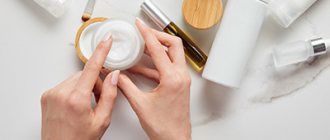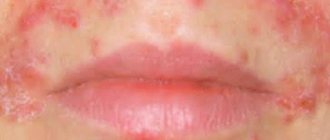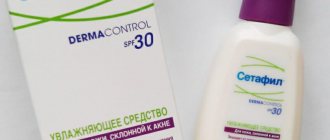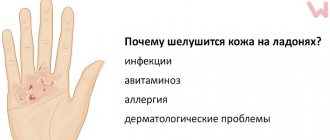You do your best to take care of your skin, but there will always be times when things go wrong and you end up with a nasty problem. Redness around the nose is a skin problem that most often occurs in the winter when your skin is already dry or chapped, but it can also happen at other times of the year. In some cases, you can add a little extra concealer, but it's always best to identify the root cause of the problem and address it.
If you notice that the skin around your nose is red, know that this is happening for a reason. Your skin reacts to your diet, your environment, and your skin care routine in ways you cannot predict. Before you apply another layer of foundation or concealer, ask yourself why your skin is red and see if you can find a way to solve the problem.
In this article we will look at the topic of redness around the nose in more detail. We'll talk about what causes it and how to reduce redness. You'll also see our top picks for professional Yon-Ka Paris to reduce redness around the nose.
What causes redness around the nose?
Your skin is the largest organ in the body and is designed to protect you from the environment. However, as your body's first line of defense, your skin takes a beating, and sometimes it shows. Redness around the nose is often a sign that your skin is deteriorating.
Redness around the nose is more likely to develop in winter, when your skin is dry and slightly cracked.
Other causes of redness include the following:
- Rosacea is a chronic skin condition that causes redness. Rosacea, unfortunately, has no cure. However, there are certain methods and medications that can reduce the redness caused by rosacea.
- Pimples (acne) - can cause the skin around your nose to become red and inflamed, especially if you keep picking at it. It's best to apply an acne treatment and leave the pimple alone.
- Perioral dermatitis is a type of rash that forms around the mouth and nose, often as a side effect of topical steroid creams.
- Skin allergies – If you are allergic to things like artificial fragrances or certain skin care products, redness around your nose could be a sign of an allergic reaction.
- Temperature changes - going from cold to hot weather outdoors can cause your skin to flush. Redness around the nose can also be caused by windburn.
- Skin irritation - sometimes the skin around your nose will become red if you rub or scratch it - this can also happen when you have a cold and are blowing your nose frequently.
Apart from these reasons, redness around the nose can also be the result of broken capillaries. Capillaries are very small blood vessels that can be affected by a number of factors, including temperature changes, hormones, sun exposure and even alcohol consumption. If you're still unsure what's causing the redness around your nose, talk to your doctor or dermatologist so they can examine and diagnose the redness.
Possible diseases
Dryness and flaking of the skin near the nose may indicate a disease. Pathologies and their symptoms are indicated in the table.
| Name | Description |
| Pathologies of the nasal cavity | Dryness and flaking of the skin may indicate rhinitis or sinusitis. The first disease is one of the most common pathologies of the respiratory tract. Rhinitis is an inflammation of the nasal mucosa of an infectious or non-infectious nature. Signs of the disease depending on the stage: 1. Dry irritation. Another name for the stage is dry. A person feels itching in the nose. Additionally, there is a constant desire to sneeze and tearing occurs. There is nasal congestion, so the sense of smell (the ability to detect odors) may be temporarily impaired. 2. Serous discharge. Another stage is called wet. A clear and watery secretion is released from the nose. The stage is characterized by a change in voice timbre due to swelling of the mucous membrane. 3. Mucopurulent discharge. Another name for the stage is purulent. The nature of the discharge changes. The secretion with pus becomes thick, the color can be yellow or green. If rhinitis is not treated, the disease will become chronic over time. In this case, the nose is constantly stuffy. Additionally, thick discharge is present, and hard crusts form in the organ cavity. With chronic rhinitis, there is a high probability of infection penetrating the pharyngeal mucosa. As a result, itching and redness in the throat and cough appear. Sinusitis is an inflammation of the mucous membrane of the sinuses (maximum, frontal, ethmoid). The disease can be caused by bacteria, viruses, allergens. Symptoms:
|
| Skin diseases | Common skin pathologies: 1. Dermatitis. Inflammation of the skin. The most common are contact, seborrheic, and atopic dermatitis. Symptoms include burning, itching, and swelling of the skin. Additionally, blisters form and redness is present. 2. Eczema. Chronic skin disease. Symptoms include inflammation and a rash on the skin. Additionally, there is a burning sensation. 3. Psoriasis. Chronic pathology of the skin. Symptoms include the formation of scaly plaques on the skin. 4. Ringworm. A disease in which various rashes appear on the skin (nodules, blisters, scales). Additionally, there is severe itching, redness, and dryness of the skin. 5. Herpes. A disease caused by the herpes simplex virus. Ulcers or blisters form on the skin or mucous membranes. 6. Demodectic mange. A pathology that occurs due to the penetration and reproduction of a tick. Its name is acne iron. Symptoms include a rash and a change in the appearance of the affected areas. In the evening and at night, itching and burning appear, since the peak activity of mites occurs at this time. 7. Rosacea. Another name is rosacea or acne. Symptoms include a change in the color of the skin - first it becomes pink and then red. Additionally, swelling of the skin appears. Spider veins and spider veins form on the epidermis, which are most often located near the nose. If the eyes are affected, the eyelids become swollen and red, and itching occurs. |
| Allergic reaction | Specific reaction of the immune system. If you are prone to allergies, the body perceives harmless substances as antigens (potentially dangerous). As a result, immunoglobulins are released that fight the components. Most often, allergies occur to pollen, food, and dust. A reaction to mold, wool, or insect bites cannot be ruled out. It is also possible to be allergic to medications and household chemicals. Symptoms:
|
| Avitaminosis | Lack of one or more vitamins in the body or problems with their absorption. Symptoms:
|
| Diabetes | A metabolic disorder in which there is insufficient production of one's own insulin, but increased levels of glucose in the blood. Symptoms:
|
| Acute respiratory diseases (ARI) | This group includes any infectious diseases of the respiratory tract that are accompanied by cold symptoms. Viruses and fungi can cause acute respiratory infections. Symptoms:
|
Simple Tips to Reduce Redness
The best treatment for redness around the nose is one that addresses the underlying cause. If you're experiencing redness and inflammation but you haven't yet identified the exact cause, you may still have some idea of what's going on.
To quickly reduce redness and inflammation, try one of these methods:
- For redness caused by skin irritation (windburn, sunburn, or dryness), apply a hypoallergenic, non-comedogenic moisturizer.
- For redness caused by acne, rosacea and other skin conditions, try a moisturizer designed to treat these specific conditions. Make sure it's suitable for your skin type so you don't make the situation worse.
If applying a topical moisturizer isn't enough to soothe inflamed and irritated skin, you may need to take it one step further. Talk to your doctor or dermatologist about your concerns and any additional symptoms you notice. Providing your doctor with as much information as possible is the only way to make an accurate diagnosis so your doctor can recommend the appropriate form of treatment.
Here are some additional tips you can try to reduce inflammation and redness:
- Use a humidifier at night to prevent your skin from becoming too dry while you sleep.
- Apply a cold compress to relieve inflammation around the nose.
- Apply some hydrocortisone to reduce swelling and redness.
- Use an LED lamp to treat redness caused by rosacea and dermatitis.
- Switch to tissue moisturizing if you are struggling with a cold or runny nose.
- Take a probiotic daily to combat harmful bacteria that may be affecting your skin.
- Try yoga or meditation to combat chronic stress.
If you're not sure what's causing the redness around your nose, you may need to try a few of our tips before you find a solution that works. In the meantime, don't use any harsh skin care products or heavy makeup, and avoid anything that isn't labeled as non-comedogenic (won't clog your pores).
Perioral dermatitis
Perioral dermatitis is a common skin disease that manifests itself as a nodular rash, in most cases localized around the mouth, including the chin area. Sometimes the rashes are concentrated on the forehead, near the nose and eyes. According to statistics, perioral dermatitis is most often diagnosed in women in the age range from 16 to 35 years. Cases of morbidity are also observed in men and children, although with less frequency.
Perioral dermatitis
A rash is the main symptom of perioral dermatitis. It appears in the form of small pink pimples or bumps. Skin rashes can be quite intense or mild, single. The occurrence of pain, as well as burning and itching, is extremely rare with perioral dermatitis.
Causes of the disease
The causes of perioral dermatitis are not fully understood. This topic is still the subject of discussion among doctors regarding factors that can provoke the disease.
The main ones are:
- using creams and ointments containing corticosteroids, such as hydrocortisone or prednisolone ointments;
- the use of certain cosmetics, including foundation;
- adverse external influences: ultraviolet radiation, wind;
- use of oral contraceptives;
- using fluoride toothpaste;
- changes in hormonal levels associated with different periods of a woman’s life: pregnancy, premenstrual period, gynecological diseases.
Dermatitis can be caused by bacteria and fungi present in the hair follicles.
Treatment
Treatment of the disease involves the abolition of steroid drugs, after which patients may experience an exacerbation, characterized by the addition of rashes on the affected areas. After a few days, the rash will begin to disappear. It is mandatory to follow a hypoallergenic diet.
Lotions based on medicinal herbs are also used:
- Decoction of string . 4 tbsp. l. and 0.5 liters of hot water are kept in a water bath for an hour, after which it is kept under a towel for another hour, filtered and cooled. Cotton pads are soaked in the product and applied to the affected areas before heating.
- Infusion of chamomile and calendula. 1 tbsp. l. chamomile and 1 tbsp. l. Brew calendula with 2 cups of boiling water, leave for an hour and strain. Soak gauze folded in several layers or cotton pads in the infusion, then apply to the problem skin. Leave for 15-20 minutes.
Itching and burning are eliminated with the help of antihistamines: Chloropyramine, Mebhydrolin, Citrine, Loratodine. Sometimes, to speed up the relief of the main symptoms, patients are prescribed sedatives.
The second stage of treatment for perioral dermatitis consists of undergoing a course of antibacterial therapy by taking tetracycline antibiotics: Metronidazolone, Doxycycline, Monocycline.
How to Avoid Worsening Skin Redness
When treating the underlying cause of your redness, there are irritants that you should avoid to avoid making the situation worse. For example, you may want to avoid wearing makeup for a few days to give your skin time to recover—you may also want to avoid direct sunlight and extreme temperatures.
Here are some other irritants you should avoid to help reduce redness around the nose:
- Alcohol, caffeine and spicy foods, which make blood vessels more visible
- Some skin care ingredients, such as alcohol
- Artificial fragrances and other additives that may irritate the skin
- Rough fabrics or fabrics that can damage or irritate the skin
If you want to reduce redness, it's important to give your skin time to recover and keep it hydrated. If you need a little extra help there are a number of skin care products you can try.
Fight against peeling
In an attempt to hide traces of peeling, many scrape off the scales, thereby injuring the young skin underneath. The correct option would be: thoroughly steam the skin and clean it with a scrub, then apply a mask with a high fat content, and only then can you remove the soaked scales.
When contacting a dermatologist, you will need to study hormonal levels and blood tests, after which you will need to strictly adhere to a hypoallergenic diet, use a vitamin-mineral complex, Laennec therapy, antibacterial and antimicrobial drugs, and in difficult cases, you will need to use hormonal ointments.
Recommended Yon-Ka Paris Products to Reduce Skin Redness
When shopping for skin care products to reduce redness around your nose, you should know your skin type. Choosing the wrong products for your skin type can make your skin too dry or too oily - this can also cause acne, which can make your redness worse.
Here are some of the best Yon-Ka Paris products to help you reduce redness:
- Sensitive Masque - With key ingredients like arnica and chamomile extracts, this soothing mask is designed for sensitive skin, while natural botanicals soothe inflammation and irritation to soothe your skin. Apply 1 to 3 times a week after cleansing and leave on for 60 minutes before gently patting and applying the remaining mask to skin.
- Creme Peaux Sensibilies - A soothing cream that boosts the skin's natural defenses and combats both physical and environmental triggers responsible for redness. It contains pre- and probiotics to nourish and repair skin, providing immediate and long-lasting relief to damaged skin. Apply to face and neck in the morning and/or evening.
- Gommage Yon-Ka Exfoliator - Exfoliates skin and reduces redness, use this gentle exfoliating and brightening gel 1 to 3 times a week after cleansing. It has a 4-in-1 formula enhanced with carob and brown algae extracts and essential oils to tighten pores and firm skin, leaving your skin hydrated, soothed and radiant.
Identifying the underlying cause of facial redness is the first step in treating it, but there are Yonka skin care products that can help you along the way.
Prevention
The likelihood of dry skin can be reduced.
To do this, you must follow the following preventive rules:
- during wind or frost, apply cream to your face;
- use protective equipment in hot weather;
- avoid frequent visits to the solarium;
- choose cosmetics and wipes with natural composition;
- purchase a room humidifier;
- if the water is hard, purchase a filter;
- observe the work and rest schedule;
- Healthy food;
- use drugs only on the recommendation of a doctor, avoid prolonged and uncontrolled use;
- do not squeeze pimples and blackheads;
- get piercings from specialists with extensive experience;
- eliminate stress;
- do not cleanse your face with antibacterial soap;
- eliminate bad habits;
- drink at least 1.5 liters of fluid per day;
- spend more time in the fresh air;
- treat diseases in a timely manner;
- undergo a preventive examination by a therapist once every 6 months;
- undergo a full examination once every 12 months.










